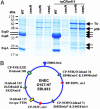Dissecting virulence: systematic and functional analyses of a pathogenicity island
- PMID: 14988506
- PMCID: PMC373508
- DOI: 10.1073/pnas.0400326101
Dissecting virulence: systematic and functional analyses of a pathogenicity island
Abstract
Bacterial pathogenicity islands (PAI) often encode both effector molecules responsible for disease and secretion systems that deliver these effectors to host cells. Human enterohemorrhagic Escherichia coli (EHEC), enteropathogenic E. coli, and the mouse pathogen Citrobacter rodentium (CR) possess the locus of enterocyte effacement (LEE) PAI. We systematically mutagenized all 41 CR LEE genes and functionally characterized these mutants in vitro and in a murine infection model. We identified 33 virulence factors, including two virulence regulators and a hierarchical switch for type III secretion. In addition, 7 potential type III effectors encoded outside the LEE were identified by using a proteomics approach. These non-LEE effectors are encoded by three uncharacterized PAIs in EHEC O157, suggesting that these PAIs act cooperatively with the LEE in pathogenesis. Our findings provide significant insights into bacterial virulence mechanisms and disease.
Figures




References
-
- Frankel, G., Phillips, A. D., Rosenshine, I., Dougan, G., Kaper, J. B. & Knutton, S. (1998) Mol. Microbiol. 30, 911-921. - PubMed
-
- Perna, N. T., Plunkett, G., 3rd, Burland, V., Mau, B., Glasner, J. D., Rose, D. J., Mayhew, G. F., Evans, P. S., Gregor, J., Kirkpatrick, H. A., et al. (2001) Nature 409, 529-533. - PubMed
-
- Hacker, J. & Kaper, J. B. (2000) Annu. Rev. Microbiol. 54, 641-679. - PubMed
-
- Elliott, S. J., Wainwright, L. A., McDaniel, T. K., Jarvis, K. G., Deng, Y. K., Lai, L. C., McNamara, B. P., Donnenberg, M. S. & Kaper, J. B. (1998) Mol. Microbiol. 28, 1-4. - PubMed
Publication types
MeSH terms
Substances
LinkOut - more resources
Full Text Sources
Other Literature Sources
Molecular Biology Databases

